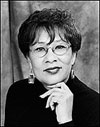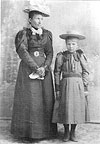Interview with the Author Lalita Tademy

From Silicon Valley, California to Louisiana, Lalita Tademy shares the journey of tracing her genealogy—the inspiration behind writing Cane River.
Walking Away from the American Dream
"I was born in Berkeley, California, in a place called Castro Valley. We were actually the first black family to move to Castro Valley. The town certainly wasn't welcoming. It was a very isolating, fairly lonely environment until I could go back into my parents' house where I was safe. The people in the town were just determined to show us how much they didn't want us there."
"My childhood had a great influence in making me very determined to be independent and listen to my own voice. And that really put me in very good stead when I started my corporate career. I had built up my career, and I had climbed the corporate ladder. After a couple of decades, I had worked myself up to being a Vice President and General Manager of a Fortune 500 Company in Silicon Valley."
"But when I walked away from [Corporate America], I think that everybody was surprised. And I know that my mother very specifically was disappointed because she was proud of the position that I had attained. If I had quit that job to go to another job, I think maybe she could have suspended disbelief for a minute. But as it was, she just shook her head. But I felt that I was supposed to be doing something else."

Becoming a Writer
"In 1995, I quit my job. And that came as a shock to many people, including myself. I started during the year that I had given myself to find out what I was going to do with the next chapter of my life. And just to fill in the extra hours, I began to do genealogy research. I did research, at first maybe just a couple days a week, and then it became every day. As I began to uncover story after story of my ancestors, I just couldn't keep away from them. And then I began to travel to Louisiana to find out more, and to be closer to the area that I now knew that my ancestors came from, Cane River. I began to understand that there were powerful stories that needed to be told."
"I literally woke up one morning and said 'I am going to write a book.' I didn't write it from chapter one. I just tried to get to know who these women [my ancestors] were. I wrote in their voices for a couple of months. I would write it as a diary, and then I would put two of them in the room together and see how they interacted with one another. And then I put three in a room together until I began to really feel that I had a handle on who they were and how they would react. And what happened was a novel."
"In 1995, I quit my job. And that came as a shock to many people, including myself. I started during the year that I had given myself to find out what I was going to do with the next chapter of my life. And just to fill in the extra hours, I began to do genealogy research. I did research, at first maybe just a couple days a week, and then it became every day. As I began to uncover story after story of my ancestors, I just couldn't keep away from them. And then I began to travel to Louisiana to find out more, and to be closer to the area that I now knew that my ancestors came from, Cane River. I began to understand that there were powerful stories that needed to be told."
"I literally woke up one morning and said 'I am going to write a book.' I didn't write it from chapter one. I just tried to get to know who these women [my ancestors] were. I wrote in their voices for a couple of months. I would write it as a diary, and then I would put two of them in the room together and see how they interacted with one another. And then I put three in a room together until I began to really feel that I had a handle on who they were and how they would react. And what happened was a novel."

Finding Cane River
"Cane River is a real place. It's a haunting, beautiful place in the center of the State of Louisiana. And it has the majestic oak trees with the dripping moss. It's lush. It's gorgeous. But it has the feel of the history of America to it as well. Before 1995, I had never even known that Cane River existed. But as I began to go and visit Cane River, I was captivated by the feel of the place."
"A lot of the areas that were the plantations that I talk about in the book no longer exist. For one thing, so much of it was burned by the Civil War. The plantation where my story is set, on the Derbanne lands, was really smaller. [The plantation] had about 40 slaves during its peak, and about 30 slaves when it was sold in 1850. It was just a one story, low slung home not at all like the grand columns and pillars. ... It's very different then the Gone with the Wind image that people have of plantations."
"St. Augustine Church was really built by a free person of color. This is where the free people of color went to church in the early 1800's, and they had reserved eight pews for the white planters along the river, too. The church itself still stands and it's quite a landmark."
"Cane River is a real place. It's a haunting, beautiful place in the center of the State of Louisiana. And it has the majestic oak trees with the dripping moss. It's lush. It's gorgeous. But it has the feel of the history of America to it as well. Before 1995, I had never even known that Cane River existed. But as I began to go and visit Cane River, I was captivated by the feel of the place."
"A lot of the areas that were the plantations that I talk about in the book no longer exist. For one thing, so much of it was burned by the Civil War. The plantation where my story is set, on the Derbanne lands, was really smaller. [The plantation] had about 40 slaves during its peak, and about 30 slaves when it was sold in 1850. It was just a one story, low slung home not at all like the grand columns and pillars. ... It's very different then the Gone with the Wind image that people have of plantations."
"St. Augustine Church was really built by a free person of color. This is where the free people of color went to church in the early 1800's, and they had reserved eight pews for the white planters along the river, too. The church itself still stands and it's quite a landmark."
Discovering the Women of Cane River
"Writing Cane River affected me actually more than I suspected it would. The day that I got the Bill of Sale that displayed, visibly, that my great-great- great-great-grandmother Elisabeth was sold in 1850 for $800 was really an amazing experience in many ways. I was first and foremost elated. It proved that she existed categorically...and very quickly, I went from elation to absolute dejection."
"Along the left-hand side of this page were the slaves' names, and three of them were three generations of my family. And then I had to come to grips with the fact that on the right-hand side of that Bill of Sale were the people that had bought them and these were my ancestors as well."
"This is not a book about slavery. This is a story about mothers and daughters. This is a story about relationships. You don't have to be a Southerner. You don't have to be African-American. You don't have to be a woman to enjoy it."
Meet the women of Cane River.
"Writing Cane River affected me actually more than I suspected it would. The day that I got the Bill of Sale that displayed, visibly, that my great-great- great-great-grandmother Elisabeth was sold in 1850 for $800 was really an amazing experience in many ways. I was first and foremost elated. It proved that she existed categorically...and very quickly, I went from elation to absolute dejection."
"Along the left-hand side of this page were the slaves' names, and three of them were three generations of my family. And then I had to come to grips with the fact that on the right-hand side of that Bill of Sale were the people that had bought them and these were my ancestors as well."
"This is not a book about slavery. This is a story about mothers and daughters. This is a story about relationships. You don't have to be a Southerner. You don't have to be African-American. You don't have to be a woman to enjoy it."
Meet the women of Cane River.

Being Color Struck in America
"One of the things that really intrigued me and that I didn't want to sidestep when I wrote this book was my own discomfort with my great-grandmother Emily's color-struck attitudes, sort of liking people better that were light skinned as opposed to darker skinned."
"In going back and doing a lot of the research, I found that field slaves and house slaves were treated differently. Lighter skinned blacks, very often who were the products of the relations between masters and slave women, often had more privileges given to them. There was a distinction in how people were treated and it lasted. It's one of the repercussions, I believe, of slavery that we are still living with in part today."
"One of the things that really intrigued me and that I didn't want to sidestep when I wrote this book was my own discomfort with my great-grandmother Emily's color-struck attitudes, sort of liking people better that were light skinned as opposed to darker skinned."
"In going back and doing a lot of the research, I found that field slaves and house slaves were treated differently. Lighter skinned blacks, very often who were the products of the relations between masters and slave women, often had more privileges given to them. There was a distinction in how people were treated and it lasted. It's one of the repercussions, I believe, of slavery that we are still living with in part today."



